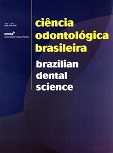Estudo da interação entre anticorpos monoclonais anti-Streptococcus mutans e antígenos de estreptococos orais
DOI:
https://doi.org/10.14295/bds.2006.v9i1.276Abstract
Nesse trabalho estudou-se a reatividade de dois anticorpos monoclonais (Acmo) anti-Streptococcus mutans (24A e 56G) desenvolvidos no Laboratório de Imunologia da Faculdade de Odontologia de São José dos Campos-UNESP, frente às cepas de estreptococos orais (S. salivarius, S. mutans e S. pyogenes) pelo ELISA e Western blot. Estes anticorpos eram da classe IgG2b e foram purificados em proteína A. O Acmo 56G mostrou ser o mais reativo com S. mutans. Testado no Western Blot (WB) com o antígeno citoplasmático (AgC) de S.mutans, 56G marcou uma única banda de 53kDa. Com o antígeno de superfície (AgSu) e com células inteiras dos microrganismos estudados, 56G reagiu com componentes de pesos moleculares mais elevados como 116 e 155 kDa. Foi detectada reatividade cruzada do Acmo 56G, no WB, com outros estreptococos orais (S. pyogenes, S. salivarius, S. sobrinus), constatando o compartilhamento de antígenos entre as espécies testadas, o que pode ser um fator importante no desenvolvimento de doenças, como a febre reumática.Downloads
Downloads
Published
How to Cite
Issue
Section
License
Brazilian Dental Science uses the Creative Commons (CC-BY 4.0) license, thus preserving the integrity of articles in an open access environment. The journal allows the author to retain publishing rights without restrictions.
=================




























